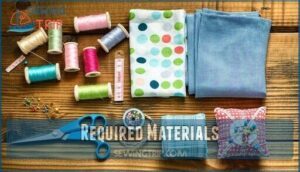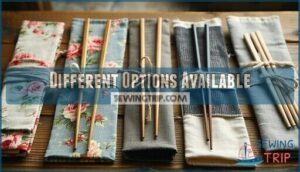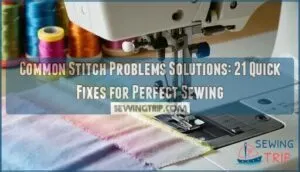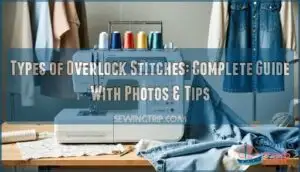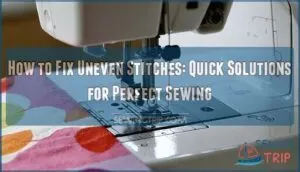This site is supported by our readers. We may earn a commission, at no cost to you, if you purchase through links.
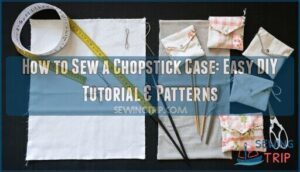 You’ll need just 30 minutes to learn how to sew a chopstick case that’s both practical and stylish.
You’ll need just 30 minutes to learn how to sew a chopstick case that’s both practical and stylish.
Start by cutting two fabric rectangles measuring 10 inches long by 4 inches wide – cotton or linen work perfectly for this project.
Place the pieces right sides together, then sew around three edges using a quarter-inch seam allowance, leaving one short end open for the chopsticks.
Turn the case right side out, press flat, and topstitch around the opening for a professional finish.
You can add ties, velcro, or snap closures for secure storage.
This beginner-friendly project transforms fabric scraps into eco-friendly utensil storage that fits most standard chopstick lengths.
The real magic happens when you discover the clever sizing tricks and decorative techniques that elevate basic cases into stunning dining accessories.
Table Of Contents
Key Takeaways
- You’ll create a functional chopstick case in just 30 minutes – Cut two 10×4 inch fabric rectangles, sew three sides with a quarter-inch seam allowance, turn right side out, and add your preferred closure method for a professional finish.
- Cotton and linen fabrics work best for durability – These materials handle regular washing, resist wear, and come in countless patterns that let you express your personal style while creating eco-friendly utensil storage.
- Proper sizing prevents chopsticks from sliding around – Measure your specific chopsticks first, then add 2-3 inches to the length for comfortable insertion, ensuring your case fits perfectly without excess fabric.
- You can customize cases for any occasion – Transform basic pouches into wedding favors with personalized name banners, create themed designs for holidays, or use fabric scraps for sustainable upcycling projects.
Materials and Design
You’ll want to choose fabrics that can handle regular use while reflecting your personal style.
Cotton and linen work best since they’re durable, easy to clean, and come in countless patterns that let you create something uniquely yours, making them a great choice to reflect your personal style.
Fabric Choices
Your fabric selection sets the foundation for a durable, stylish chopstick case.
Cotton options offer breathability and easy washing, while linen textures provide natural elegance and strength.
For eye-catching designs, consider animal prints or traditional Japanese motifs that reflect your personality.
Sustainable fabrics like organic cotton and bamboo align with eco-friendly values, reducing environmental impact.
Choose tightly woven materials for longevity and pre-wash to prevent shrinkage.
Canvas adds structure for heavy use, while lighter cottons work perfectly for everyday cases.
Your fabric choices should balance practicality with personal style preferences.
When selecting materials, consider using eco friendly options to minimize waste and support sustainable practices.
Size and Dimensions
Getting your measurements right sets the foundation for a successful chopstick case. The ideal dimensions hover around 9 inches in case length, providing ample space for standard chopsticks while maintaining portability.
This measurement tips sweet spot guarantees your utensils won’t peek out awkwardly or swim around inside.
Folded corners aren’t just about looks—they’re your secret weapon for durability. These corner styles create reinforced edges that withstand daily use and washing.
When planning your measurements, add an extra half-inch to accommodate the fold, giving you crisp, professional-looking corners that won’t fray over time.
Size variations can accommodate different chopstick lengths, so measure your specific utensils before cutting fabric.
This sewing tutorial approach prevents frustrating do-overs and guarantees your finished chopstick case fits like a glove. Understanding the concept of fabric drape is vital for selecting the right material and achieving the desired design.
Alternative Design Options
Your chopstick case doesn’t need to follow traditional rules.
Mix bold Color Schemes with subtle Pattern Mixing for visual interest.
Consider different Textile Choices beyond cotton—try canvas for durability or silk for elegance.
Add Embellishment Ideas like decorative buttons or embroidered details.
Experiment with Folded Designs that create unique shapes when closed.
These creative approaches transform a simple sewing tutorial into personalized DIY sewing projects that reflect your style.
DIY Chopstick Case Pouch Tutorial
You’ll transform two simple fabric triangles into a practical chopstick case that rolls up neatly and ties closed.
This beginner-friendly project takes about 30 minutes and requires basic sewing skills to create a reusable case that fits standard chopsticks perfectly.
Required Materials
Before you start cutting fabric, let’s gather your sewing supplies. You’ll need two contrasting fabric pieces for visual appeal – cotton fabrics work best for durability and easy cleaning.
Choose thread colors that complement your fabric selection. Essential sewing tools include sharp scissors, measuring tape, pins, and a sewing machine or hand-sewing needles.
Don’t forget a 30cm ribbon or cord for closure and a cord lock if desired. Pre-wash your fabric to prevent shrinkage.
Having quality sewing patterns and the right fabric types makes this DIY sewing project much smoother. Using eco-friendly materials can help reduce waste through reusable bag practices, which is a great way to promote sustainable and environmentally friendly habits.
Step-by-step Instructions
Now that you’ve gathered your materials, let’s walk through this step-by-step guide to create your DIY chopstick case. These sewing tutorials make case construction straightforward, even for beginners.
Begin by placing your two fabric pieces right sides together, creating a neat sandwich. Pin along the edges to keep everything aligned during sewing. This fabric prep step prevents shifting and guarantees clean lines.
Next, sew around three sides using a straight stitch, leaving the top open for turning. Remember to backstitch at the beginning and end for durability. Trim corners at an angle to reduce bulk when you turn the case right side out.
Turn your case inside out and push corners out gently using a chopstick or similar tool. Press seams flat with an iron for crisp edges.
For finishing touches, topstitch around the opening and add your chosen closure. Whether you prefer ribbon ties, velcro, or elastic, secure them firmly. These sewing tips guarantee your sewing project withstands regular use while looking professional.
Variety of Chopstick Cases and Boxes
You’ll find chopstick cases in many forms, from simple fabric pouches to elegant wooden boxes that suit different occasions and preferences.
Whether you’re looking for a basic travel case or decorative storage, options range from handmade fabric versions to polished bamboo containers available at kitchen stores, online retailers, and specialty Asian markets.
Different Options Available
Before diving into your DIY chopstick case project, consider the wealth of Material Choices available to transform your sewing projects.
Fabric Types range from durable cotton to luxurious silk, while Case Styles span minimalist designs to elaborate patterns.
Closure Options include elastic bands, snap buttons, or traditional ties, and Design Variations let you create everything from simple chopstick pouches to elaborate reusable cases that reflect your personal style and DIY creativity.
For inspiration, you can explore online stores with chopstick cases to find the perfect design for your needs.
Features and Designs
Creative designs transform your chopstick case from functional to fabulous, making each sewing project a personal statement. Modern handmade cases showcase endless possibilities through thoughtful design choices that reflect your unique style.
Today’s fabric case options span every aesthetic preference imaginable. Color Options range from bold, vibrant hues to subtle earth tones, while Fabric Textures include smooth cotton, textured linen, and even metallic accents. Pattern Choices encompass everything from traditional florals to contemporary geometric designs.
- Closure Styles featuring buttons, elastic loops, ties, or magnetic snaps
- Embellishments like embroidery, appliqué, beading, or decorative stitching
- Contrast linings that surprise and delight when opened
- Quilted surfaces adding dimension and durability
- Themed designs celebrating holidays, seasons, or personal interests
Your chopstick pouch becomes a conversation starter when you incorporate unique elements that speak to your personality and crafting vision. Effective storage solutions, such as those using needle storage cases, can also inspire creativity in sewing and crafting projects.
Where to Find Them
You’ll find chopstick cases at Online Stores like Amazon and Etsy, where handmade case options abound.
Department Stores often stock basic fabric case designs in their kitchen sections. Craft Fairs showcase unique chopstick holder creations from local artisans who understand quality sewing projects.
Fabric Shops frequently display finished samples alongside materials, letting you touch and feel before purchasing. Second Hand stores sometimes surprise you with vintage finds.
Asian grocery stores typically offer traditional bamboo and wooden options. For the widest selection, browse specialty dining retailers that focus on chopstick case varieties.
Each source offers different price points and styles to match your needs. The quality of chopstick cases can vary substantially depending on the materials used.
Chinese Banquet Chopstick Cases
You’ll create festive chopstick cases perfect for Chinese New Year celebrations using simple materials like paper squares, tape, and scissors.
This kid-friendly project encourages creativity while adding personalized cultural elements to your festivities, making it a great way to celebrate with Chinese New Year traditions.
Craft Project for Chinese New Year
Chinese New Year’s arrival transforms your home into a canvas for Cultural Crafts that celebrate tradition while creating lasting memories.
Making chopstick cases becomes an engaging family activity that brings everyone together around the table, turning simple materials into meaningful Chinese Decor.
Here’s what you’ll need for this festive sewing project:
- Red Envelopes or festive wrapping paper – repurpose these Lucky Charms for authentic cultural significance
- 6" x 6" colored paper squares – choose vibrant reds and golds for traditional appeal
- Basic crafting supplies – scissors, tape, and glue stick for assembly
- Decorative elements – wax seals, ribbons, or small embellishments for Festive Designs
- Family participation – involve children in this DIY activity for shared creativity
This chopstick case craft perfectly bridges traditional Chinese New Year celebrations with modern sewing techniques.
Children can practice basic folding and cutting skills while adults guide the more intricate sewing projects.
The finished cases add personalized touches to your banquet table, creating conversation starters that honor cultural heritage while showcasing your family’s creativity.
Simple and Quick Project
This sewing project won’t eat up your whole afternoon. You’ll master this chopstick case in under an hour, making it perfect for last-minute gifts or quick DIY crafts.
Hand stitching techniques keep things simple while fabric selection adds your personal touch. The project’s simplicity makes it ideal for exploring various sewing projects to enhance your skills.
| Time Investment | Skill Level |
|---|---|
| 30-45 minutes | Beginner-friendly |
| Minimal prep work | Basic sewing tips needed |
| Quick results | Perfect first project |
The beauty lies in the straightforward approach – no complex patterns or advanced sewing techniques required. Your sewing project becomes a stress-free experience that delivers professional-looking results every time.
Tutorial and Materials Needed
You’ll need basic materials for this simple project. For fabric selection, choose lightweight cotton or decorative paper in festive colors.
Your sewing tools include scissors, tape, and a ruler. Material costs stay low – paper squares cost under $5.
Follow these sewing tips: cut precise measurements, fold cleanly, and secure edges with tape. This tutorial teaches basic sewing techniques perfect for beginners.
The case patterns work with any chopstick length, making crafting tips simple to follow.
Themed Wedding Chopstick Sleeve Place Cards
Transform your wedding reception into a memorable experience by creating elegant chopstick sleeve place cards that double as unique keepsakes.
You’ll repurpose travel-themed wrapping paper and personalize each sleeve with your guests’ names on linen cardstock banners for a sophisticated touch.
Repurposing Materials
Your creative journey starts with fabric scraps from old clothes, transforming textile waste into stunning chopstick cases through repurposing magic.
That worn-out denim jacket becomes upcycled denim perfection with clever sewing techniques. Raid your closet for forgotten treasures – vintage buttons, ribbons, and fabric remnants breathe new life into your sustainability project.
Creative reuse turns yesterday’s discards into tomorrow’s treasures. You’ll save money while reducing waste, making each case a conversation starter about upcycling innovation.
See how you can source quality fabric remnants for your project.
This eco-friendly approach proves that one person’s trash truly becomes another’s treasure through thoughtful repurposing.
Personalizing With Guests’ Names
Your guests’ names transform ordinary chopstick cases into memorable keepsakes with thoughtful personalization.
Create elegant linen cardstock banners featuring each guest’s name using careful calligraphy styles or sophisticated font choices.
Consider these personalization approaches:
- Banner materials – Select high-quality cardstock that complements your wedding theme and fabric choices
- Inscription methods – Use calligraphy pens, elegant printing, or digital design for professional results
- Wax seal designs – Add handcrafted seals matching your wedding colors for sophisticated finishing touches
This sewing project elevates simple chopstick case construction into cherished wedding favors that guests will treasure long after your celebration ends.
Tools and Steps Required
Throughout your wedding crafting journey, you’ll need specific tools and follow these steps to create elegant chopstick sleeve place cards.
Essential tools include scissors, X-Acto knife, and glue stick for precise cutting and assembly.
Your sewing ruler guarantees accurate measurements while stitching techniques create professional results.
| Tool Category | Primary Tools | Purpose |
|---|---|---|
| Cutting Tools | Scissors, X-Acto knife | Precise paper cutting |
| Measuring | Sewing ruler, measuring tape | Accurate dimensions |
| Assembly | Glue stick, wax seals | Secure attachment |
| Sewing | Needles, thread | Corner folding, seam pressing |
| Finishing | Iron, pins | Closure mechanisms |
Begin by preparing your travel-themed wrapping paper and linen cardstock.
Cut sleeves to size using your sewing ruler for consistency.
Apply step-by-step instructions: fold corners, press seams, and attach closure mechanisms.
This sewing guide transforms simple materials into memorable keepsakes.
Master these sewing techniques through practice, making this project perfect for sewing for beginners seeking elegant results.
Frequently Asked Questions (FAQs)
How do you sew a cutlery pouch?
Cut two fabric rectangles to your desired pouch size, adding seam allowances.
Pin them together with right sides facing, then sew around three edges, leaving one end open.
Turn right side out, press seams flat, and add your preferred closure method.
This will ensure your pouch is complete and functional, with the seam allowances properly accounted for.
How do you sew a pocket?
Position two fabric pieces right sides together, pin edges carefully, then stitch around perimeter leaving small opening.
Turn right side out through opening, press seams flat, and hand-stitch gap closed for a professional finish to ensure the seams are flat.
How do you sew a 6×6 pocket?
For a 6×6 pocket, you’ll cut fabric 7×7 inches to allow for seam allowances.
Fold the top edge down half an inch, then fold raw edges under.
Pin the pocket where you want it, then stitch around three sides, leaving the top open for access.
How do you sew a caddy?
Creating a caddy that’ll absolutely revolutionize your organization game starts with measuring your space requirements.
Cut fabric pieces to desired dimensions, sew pockets with reinforced seams, attach sturdy handles, and finish edges cleanly for maximum durability.
Can chopstick cases be machine washed?
Yes, you can machine wash chopstick cases made from cotton or linen fabrics.
Use cold water and gentle cycle to prevent shrinkage and fading.
Air dry them to maintain their shape and durability for long-term use.
How do I reinforce weak seam areas?
You’ll want to double-stitch stress points where corners meet seams. Add interfacing to weak areas before sewing, and reinforce closure attachment points with extra stitching or small fabric patches.
What thread weight works best for durability?
Professional seamstresses report that 40% of chopstick case failures occur at stress points.
Use heavy-duty thread weight 40 or 50 for maximum durability. You’ll achieve stronger seams that won’t snap under daily use and washing.
How do I prevent fabric from fraying?
Use zigzag stitching along fabric edges to prevent fraying. You can also apply liquid seam sealant or cut with pinking shears for a decorative finish that naturally resists unraveling.
Can I make cases for longer chopsticks?
Simply adjust your fabric measurements to accommodate longer chopsticks.
Measure your chopsticks first, then add 2-3 inches to the length for comfortable insertion and closure.
The width remains the same, ensuring your case fits perfectly.
Conclusion
Picture Sarah rushing to pack lunch for her husband’s office potluck – she quickly slips his favorite bamboo chopsticks into the handmade case she’d sewn the weekend before.
Now you’ve mastered how to sew a chopstick case that’s both functional and beautiful.
These simple pouches protect your utensils while reducing single-use plastic waste.
With basic sewing skills and thirty minutes, you’ve created eco-friendly storage that fits any dining style.
Your chopsticks stay clean, organized, and ready for every meal, which is a great way to promote a sustainable lifestyle.

